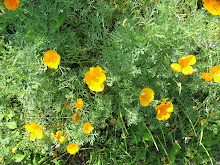The room was filled with mainly Minton Stable Gardeners, BNAN staff, a few Midway regulars, and members of the Whitehaus, a Jamaica Plain-based collective of artists behind most of the performances that evening. Some of the Whitehaus folks looked familiar; it was very cool to discover this other side of some of my fellow gardeners. A fundraising raffle was part of the festivities; I was lucky to win a BNAN membership and a book, leading some to joke that the operation was rigged.
The first band I heard, Peal & Lash (above), provided fun thrashing rock, the loudest music of the evening. They were followed by D.A. Boucher, who recited and performed an unforgettable revisionist take on Peter Cottontail, complete with Whitehaus family members posing as vegetables at risk.
 Next were The Woodrow Wilsons (below), with their lovely vocal harmonies layered over acoustic guitar and xylophone (not shown).
Next were The Woodrow Wilsons (below), with their lovely vocal harmonies layered over acoustic guitar and xylophone (not shown).

Joe Bergin read a special poem he wrote about the garden and John Carroll (note to self--get a copy!).
Peace, Loving was up next. This experimental group left most of their chains and bowls at home, leaning toward more of an acoustic folk sound, including some powerful poetry provided by the member at the far left in the photo below. Another Whitehaus member, Lindsay Clark, performed a stunning solo set, her voice floating over rootsy banjo picking.



Brian Ellis, above right, read his mind-bending poetry. His verse about a Greyhound bus ride down the east coast as a metaphor for a bad relationship was quite engaging. Ed Masuga's acoustic folk was a nice finish to the evening.

I hope that this benefit went far to beef up BNAN's budget for this summer's series, and that some of these performers and others who are just as good bring their music to the gardens this summer.






